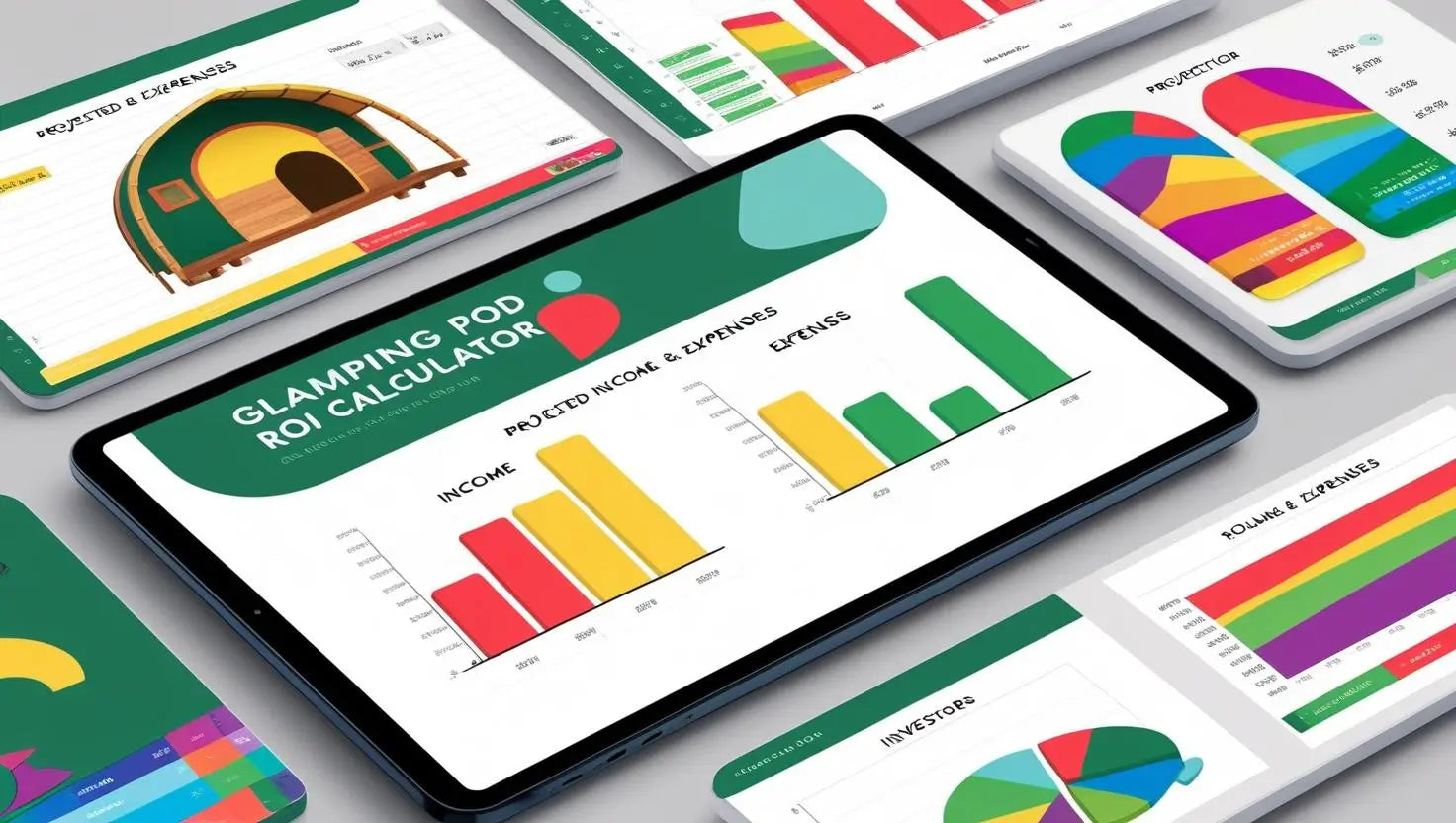Read Time: 5 mins

Housing affordability in the UK and Ireland is under increasing pressure. The average house price reached £269,000 in May 2025, marking a 3.9% annual rise, up from 3.6% the previous month (ONS). At the same time, average private rents climbed to £1,339 per month, a 7% increase over the year, although the pace of growth has slowed compared to earlier in 2025 (ONS, Krispyhouse).
Despite this slight easing, rents remain stubbornly high, and forecasts suggest continued upward pressure in the months ahead (The Times). These financial strains are driving many families to explore off-grid modular pods, compact, self-sufficient homes that offer autonomy, lower running costs, and a sustainable alternative to traditional housing.
Quick Answer: Land Requirements
| Use Case | Recommended Land |
| Utilities only (pod with solar, rainwater harvesting, composting toilet) | 0.2–0.5 acres |
| Comfortable self-sufficiency (utilities + kitchen garden + small livestock) | ~1 acre |
| High self-reliance (growing most food, livestock, woodlot) | 3–5 acres; examples like Wales’ One Planet Developments typically span ~5 acres |
(Note: Specific farming or zoning regulations influence this—see Planning section below.)
What Actually Takes Up Space on Your Plot
Pod Footprint & Utility Infrastructure
• A family-sized pod typically occupies 20–50 m². Allow extra space for decking, a battery/storage shed, and access for maintenance.
• This small footprint makes pods far easier to site and less invasive than traditional homes.
Renewable Energy: Solar (and Maybe Wind)
• A standard 4 kWp solar PV system, enough to power a small home, typically covers 20–26 m² of unshaded roof or ground space (The Renewable Energy Hub).
• These systems commonly produce 3,000–3,400 kWh/year, enough to cover most energy needs of a 3–4 person household (GreenMatch).
Water & Waste
• Rainwater harvesting: Gutters feed into tanks (above or below ground); typically located near the pod.
• Boreholes: Feasible in rural areas, but large extractions may require permits.
• Sanitation: Composting toilets are compact and self-contained. Septic systems need more space and must be safely distanced from watercourses. See our Eco-Friendly Portable Outdoor Dry Composting Toilet.
Food Production
• A 100–250 m² kitchen garden can supply most vegetables for a family, think approximately half a tennis court (The Renewable Energy Hub).
• Adding small livestock (chickens or ducks) pushes you toward the ~1 acre mark.
• For larger livestock or woodlots, plan on 3–5 acres as optimal.

UK & Ireland Planning Realities (Residential Use Only)
Getting planning permission for off-grid pods is often the biggest hurdle, not the land size.
• Wales: The One Planet Development (OPD) route is an established framework for self-sufficient residences. It mandates a detailed land-use management plan and proof of meeting basic needs within five years, typically on 5-acre plots (Office for National Statistics).
• England & Scotland: No dedicated OPD scheme. Rural build permission is required. Plots with derelict or existing dwellings are easier to convert than undeveloped agricultural land.
• Ireland: Even more restrictive, most rural builds require full planning permission, often subject to "local needs" tests. There's no equivalent to OPD, so even larger plots don’t guarantee permission.
Tip: Always start by discussing your intention and site with local planning officers. A feasibility study, such as the GlampLaunch Feasibility Study service, can evaluate your proposed site’s potential, zoning issues, and help frame your application for residential off-grid use. Visit the service here:
Off-Grid Pods vs Traditional Homes: The Money Case
House Prices, Rents & Mortgages
• House prices have hovered around £268,400–£269,000 in mid-2025, with annual growth of ~1.3–3.9%, depending on the source (Office for National Statistics).
• Rents for new tenancies average £1,287/month, a 2.8% year-on-year increase, the slowest in four years (The Times).
Pod Pricing (GlampLaunch Example)
• Off-grid residential pods start at £32,495 ex VAT (£38,994 inc VAT include kitchen, bathroom, living room, and bedroom).
• Even financed over 10 years at 5–6% APR, this equates to £420–£430/month, roughly one-third of average UK rent and far lower than mortgage or rent costs.
See our recommended pods for off-grid living:
-
The “Dual Halfmoon” Pod – Luxury 2-Person Glamping Pod
With its curved double-arched roofline, the Dual Halfmoon combines striking aesthetics with smart use of space. Perfect for couples, it includes a cosy interior that’s easy to heat and maintain, making it ideal for year-round off-grid living.
Starting price: £32,495.00 + VAT
The “Hobbit” Pod – Luxury 2-Person Glamping Pod
Inspired by Tolkien-style hideaways, the Hobbit Pod blends rustic charm with modern build quality. Compact but character-filled, it’s a great option for those wanting a pod that feels both magical and practical.
Starting price: £27,495.00 + VAT
The “Viking’s Keep” Pod – Luxury 2-Person Glamping Pod
This pod channels Scandinavian sturdiness with a bold design and durable construction. Built to withstand harsher climates, it’s well-suited to rural and exposed sites where resilience is key.
Starting price: £24,995.00 + VAT
The “Grotto” Pod – Luxury 2-Person Glamping Pod
With its organic lines and natural look, the Grotto Pod feels like part of the landscape. It’s a stylish choice for anyone who wants their off-grid home to blend seamlessly with nature.
Starting price: £14,995 + VAT
Running Costs & Sustainability
With solar, rainwater, and composting systems, utility bills can drop by up to 60% compared with mains-connected dwellings.
Pods are built with eco-timber and high-performance insulation, giving them a lifespan of 20+ years, on par with cabins or park homes.

Conclusion
With mortgage rates still hovering around 4–5% and rents at record highs, there has rarely been a better time to consider an off-grid alternative. Modular pods offer families the chance to reduce housing costs, gain energy independence, and build a sustainable lifestyle that isn’t at the mercy of rising bills or volatile property markets.
If you’re ready to take the next step, start by exploring whether your land is suitable with a GlampLaunch Feasibility Study.
For a deeper look at the practicalities of off-grid living, read Living Off-Grid in the UK: The Complete 2025 Guide to Sustainable, Mortgage-Free Living. And if you’d like tailored advice, you can always book a free 20-minute call with Taylor below the FAQs section to discuss your land, planning, and pod options.
Summary
• 0.2–0.5 acres is enough for a pod with solar, rainwater, and composting; ~1 acre supports a kitchen garden and small livestock; 3–5 acres allow fuller self-sufficiency with food and fuel.
• A pod itself only takes 20–50 m², but extra space is needed for solar (20–26 m² for 4kWp), tanks, septic or composting systems, and gardens (100–250 m² for veg).
• Planning permission is often harder than land size: Wales offers OPD (5 acres, strict rules), while England, Scotland, and Ireland require standard rural permissions, often restrictive.
• House prices average £269k and rents £1,339/month (May 2025). Off-grid pods cost £14,995–£32,495 + VAT, with finance ~£420–£430/month, much lower than rents or mortgages.
• Off-grid systems can cut bills by 60%. Pods are eco-built, well-insulated, and last 20+ years.
• GlampLaunch pods include the Dual Halfmoon, Hobbit, Viking’s Keep, and Grotto, offering durable and customisable off-grid options.
FAQs
1. How much land do you need for an off-grid pod in the UK or Ireland?
For basic utilities like solar power, rainwater harvesting, and a composting toilet, you can live comfortably on 0.2–0.5 acres. A kitchen garden and small livestock push this closer to 1 acre, while families aiming for high self-reliance with larger food production or woodlots usually need 3–5 acres.
2. What actually takes up space on an off-grid pod plot?
A pod itself typically uses only 20–50 m², but you’ll also need room for decking, a storage shed for batteries, and access paths. Solar panels take around 20–26 m² for a 4 kWp system, while a kitchen garden may need 100–250 m². Adding livestock, drainage, and water systems increases the overall land requirement.
3. What planning permission rules apply to off-grid pods?
In Wales, the One Planet Development (OPD) scheme allows sustainable homes on ~5 acres, provided residents meet 65% of their needs from the land. In England and Scotland, you’ll need rural build permission, with conversions of derelict sites often easier than new builds on farmland.
In Ireland, planning is stricter, often requiring local-needs tests, and there’s no OPD equivalent.
4. How do off-grid pod costs compare with traditional housing?
With UK house prices averaging £269,000 and private rents at £1,339/month (ONS 2025), off-grid pods offer major savings. For example, a fully equipped pod from GlampLaunch starts at £32,495 + VAT, with finance repayments of around £420–£430/month, about one-third of average rent.
Running costs are also up to 60% lower with solar, rainwater, and composting systems.





